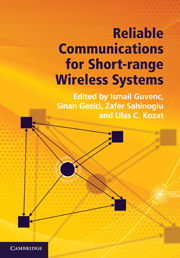Book contents
- Frontmatter
- Contents
- List of contributors
- 1 Short-range wireless communications and reliability
- Part I High-rate systems
- 2 High-rate UWB and 60 GHz communications
- 3 Channel estimation for high-rate systems
- 4 Adaptive modulation and coding for high-rate systems
- 5 MIMO techniques for high-rate communications
- Part II Low-rate systems
- Part II Selected topics for improved reliability
- Index
4 - Adaptive modulation and coding for high-rate systems
from Part I - High-rate systems
Published online by Cambridge University Press: 01 June 2011
- Frontmatter
- Contents
- List of contributors
- 1 Short-range wireless communications and reliability
- Part I High-rate systems
- 2 High-rate UWB and 60 GHz communications
- 3 Channel estimation for high-rate systems
- 4 Adaptive modulation and coding for high-rate systems
- 5 MIMO techniques for high-rate communications
- Part II Low-rate systems
- Part II Selected topics for improved reliability
- Index
Summary
As wireless channels are fading and error-prone in nature, the adaptive modulation and coding (AMC) scheme is important in wireless communication systems to enhance reliability and spectral efficiency. By adapting transmission schemes to time-varying channels conditions, AMC can provide attractive rate and error performance characteristics. AMC has been widely adopted in the wireless standards, such as GSM and CDMA cellular systems, IEEE 802.11 WLANs, IEEE 802.16 WMANs and also the WPANs based on the short-range ultra-wideband (UWB) systems like the multi-band orthogonal frequency division multiplexing (MB-OFDM) and millimeter wave (MMW).
On the other hand, the automated repeat request (ARQ) scheme is typically used as the link-layer error-control mechanism. By retransmitting the corrupted packets, ARQ can further improve the reliability of wireless systems. The interaction of the queueing and ARQ in the link layer with AMC in the PHY layer provides interesting cross-layer design problems.
The AMC adopted in the conventional narrowband systems over flat-fading channels (e.g., Rayleigh and Nakagami-m fading) has been studied extensively in the literature [1–4]. There has also been considerable interest in the design and analysis of joint AMC and ARQ transmission systems [5–8]. However, the performance of AMC in short-range high-rate systems, considering the UWB channel characteristics and media access control (MAC) protocols, is much less explored. This chapter is intended to fill this gap by presenting a detailed study of the error-control mechanisms employed in high-rate WPANs.
- Type
- Chapter
- Information
- Reliable Communications for Short-Range Wireless Systems , pp. 93 - 112Publisher: Cambridge University PressPrint publication year: 2011
- 1
- Cited by



